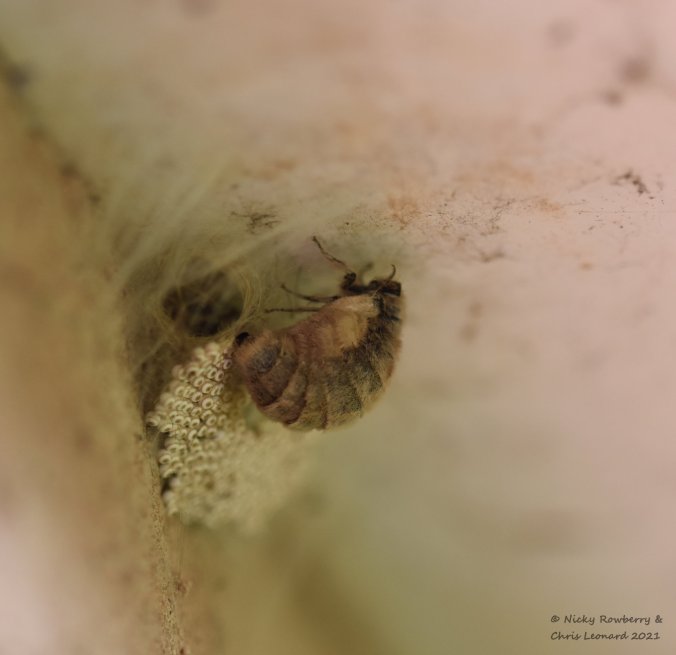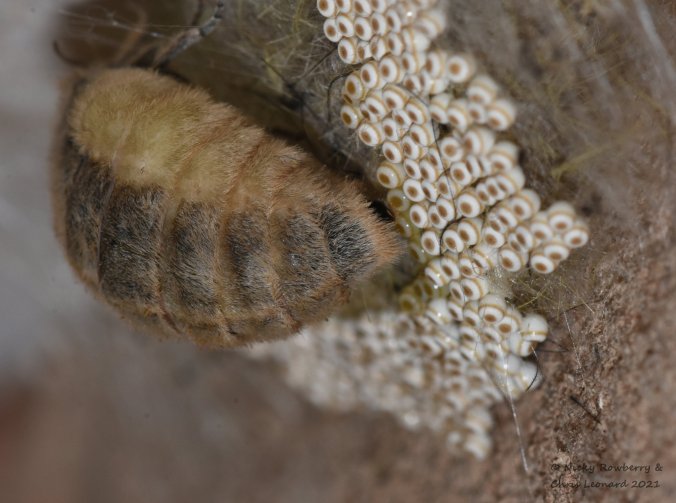This week I finally got to see a moth I’ve been wanting to see for a very long time – a female Vapourer. We often see Vapourer caterpillars in the garden and sometimes the male adult moths, but the female is something else. The female Vapourer has the, perhaps unenviable, trait of being flightless! Her life as a caterpillar proceeds the same as the male, but when she pupates, instead of emerging with beautiful wings, she appears as short dumpy lump who can hardly move (perhaps this is why I empathise with her!). A female Vapourer’s lot is not a glamorous one.
Back at the beginning of July I spotted this large Vapourer caterpillar on the garage wall. They are spectacular looking caterpillars with tufts protruding here, there and everywhere.
This caterpillar very purposefully headed up the garage wall until it reached the overhang at the top – and there it settled. I saw it there an hour or so later and at first thought it had been snared by a spider’s web, but it was in fact pupating.
The caterpillars spin themselves a fairly thin whispy cocoon and can emerge as an adult within 2 weeks. The good people on a local Facebook group suggested this could be a female, so I checked the cocoon every day for weeks hoping to catch it emerge. Sadly just as the time should have been up, it looked like the garden sparrows or blue tits had pecked her out of her cocoon. We often see them pecking at small spiders and insects on the walls and it seemed this was her fate.
 Fortunately that same week, I spotted another 2 caterpillars – also on the garden wall, but this time choosing a slightly safer place to pupate – beneath the garage windowsills. Tucked away there, they were less visible to the birds and perhaps stood a better chance. These ones also had the advantage (for me) of being much lower down the wall, so I could watch them more closely. The caterpillars (at this stage I didn’t know whether I’d got males or females) use some of their hairs and tufts to “decorate” the cocoon. Since these hairs are irritants, this may serve to provide additional protection to the developing moth inside. You can see various hairs and tufts on the picture below, photographed under the windowsill.
Fortunately that same week, I spotted another 2 caterpillars – also on the garden wall, but this time choosing a slightly safer place to pupate – beneath the garage windowsills. Tucked away there, they were less visible to the birds and perhaps stood a better chance. These ones also had the advantage (for me) of being much lower down the wall, so I could watch them more closely. The caterpillars (at this stage I didn’t know whether I’d got males or females) use some of their hairs and tufts to “decorate” the cocoon. Since these hairs are irritants, this may serve to provide additional protection to the developing moth inside. You can see various hairs and tufts on the picture below, photographed under the windowsill.
On Sunday, exactly 14 days after I’d seen her crawl under the windowsill, a female Vapourer emerged. When they emerge the females emit pheromones to attract the males. Since the females can’t really move, the males have to come to them and the pheromones draw them in very quickly. So quickly in fact that I missed this stage of the process. I’d checked the cocoons at about 8am – no sign of any activity. I was out for the morning and by the time I checked again at noon, the female was in full egg-laying mode. The males had been and gone. Disappointing as that was, it was still fantastic to see the female laying eggs. Here are a selection of photos taken somewhat awkwardly beneath the windowsill.
On the photo below you can see what I think are the vestigial remains of wings – looking like fluffy ears, either side of her head.
Her body is really a furry sac, stuffed fill of eggs. She has legs at the front to hold on to the cocoon.
The eggs are laid directly onto the cocoon. They looked wet and a sort of olive colour as they emerged but soon turned white with a darker centre spot.
I did try to video the process, not easy as the light wasn’t great underneath the windowsill. She works determinedly laying egg after egg, all neatly arranged on the remains of the cocoon.
In all she laid 401 eggs – I read online that they can lay between 200 and 400, so she excelled herself!
I suppose I should show a photo of a male Vapourer, although their contribution to the whole process is fleeting to say the least. He is, it has to be said, a very attractive moth, with large feathery antennae for detecting the females’ pheromones.
Sadly once the female finishes laying her eggs, she dies. Her body by then has shrunk and shrivelled once it is empty of eggs. I found this one the next day lying on the ground beneath the windowsill, her eggs still safely sitting on the cocoon. I actually felt quite sad to see her like that, but her work was done and with 401 eggs she had hopefully ensured her genes would live on. Her adult life may have been brief, but she packed a lot into it. Flightless she may have been, but to me a fabulous moth.










Really interesting, thanks!
LikeLike